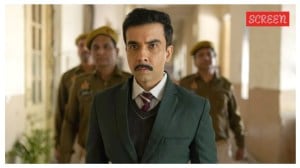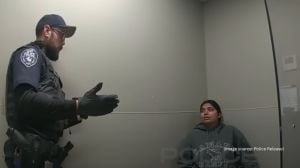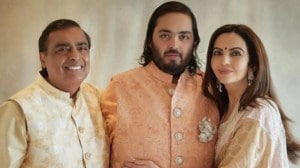Article 370 hearings: Who was Gopalaswami Ayyangar and what was his ‘commitment’ to the people of J&K
Ayyangar served as the Prime Minister of J&K; was part of the Constitution’s drafting committee and presented Draft Article 306A (later called Article 370) to the Constituent Assembly
 In 1937, N Gopalaswami Ayyangar was appointed the 'Diwan' or Prime Minister of J&K by Maharaja Hari Singh. (Photo: Wikimedia Commons)
In 1937, N Gopalaswami Ayyangar was appointed the 'Diwan' or Prime Minister of J&K by Maharaja Hari Singh. (Photo: Wikimedia Commons) During the hearings in the Supreme Court on the abrogation of Article 370, senior advocate Dinesh Dwivedi questioned the changes made by the government to the Article granting special status to Jammu and Kashmir, saying the provision had ceased to operate after the J&K Constituent Assembly went out of existence in January 1957.
To buttress his argument, Dwivedi cited the speech of N Gopalaswami Ayyangar to the Constituent Assembly of India on the “commitment” made to the people of J&K. Dwivedi argued that if the debate said that there was a “commitment that J&K Legislative Assembly would decide the Constitution, what is the use of the commitment made, and what is the use of the Constitution when it cannot finally lay down anything?”.
Chief Justice of India D Y Chandrachud responded: “You are now trying to read the ingredient of finality from Constituent Assembly debates. How can that be?”
The CJI also asked whether the speech by an individual member of the Constituent Assembly, “however weighty”, can represent a “commitment by the nation or the dominion of India to the state of Jammu and Kashmir”. This, he said, “would have a bearing on the interpretation of the Constitution”.
But who was Gopalaswami Ayyangar and what was the speech in question?
A native of Tanjore, Narasimha Gopalaswami Ayyangar joined the Madras Civil Service in 1905 and served in several posts, including District Collector and Member of the Board of Revenue. In 1937, he was appointed the ‘Diwan’ or Prime Minister of J&K by Maharaja Hari Singh.
He was elected to the Council of States in 1943 and served in the post until 1947. He went on to be elected to the Constituent Assembly by the Madras Assembly, and was part of the seven-member Drafting Committee – including B.R. Ambedkar (who was the Chairman of the drafting committee), Alladi Krishnaswami Ayyar, K M Munshi, Mohammad Saadulla, B L Mitter, and D P Khaitan.
In his book, Mission with Mountbatten, Alan Campbell-Johnson writes that the Indian Cabinet established a Defence Committee on September 30, 1947, comprising both Indian and British members. The British side comprised Governor-General Lord Mountbatten, and the three British Commanders-in-Chief. The Indian side included Prime Minister Jawaharlal Nehru, Deputy PM Sardar Vallabhbhai Patel, Defence Minister Sardar Baldev Singh, the Minister of Finance, and “a minister without portfolio, Sir Gopalaswami Ayyengar (or, sometimes, Iyengar)”.
“The presence of Ayyengar is interesting,” writes Campbell-Johnson. “He had been Prime Minister of Jammu and Kashmir in 1936-43 and had the reputation of being a hard man. It has been suggested that his presence in the Cabinet, which he joined at the very end of September 1947, was directly related to the Kashmir problem. It may be significant that Nehru regarded Ayyengar as the one former Prime Minister of Jammu and Kashmir then in circulation who had enjoyed a tolerable working relationship with Sheikh Abdullah.”
By virtue of his role in the Defence Committee, Ayyangar played a key role in deliberations between Nehru, Patel, Abdullah and three others from the J&K side.
As part of the drafting committee of the Constitution, Ayyangar helped put in shape Article 370, which defined the special relationship of J&K with the Indian Union. On October 17, 1949, Ayyangar introduced ‘Draft Article 306A’ (later called Article 370) to the Constituent Assembly.
Its member Maulana Hasrat Mohani raised the question as to why this “discrimination” or special treatment was being accorded to J&K. In response, Ayyangar said the “discrimination is due to the special conditions of Kashmir”.
“That particular state is not yet ripe for this kind of integration. It is the hope of everybody here that in due course even Jammu and Kashmir will become ripe for the same sort of integration as has taken place in the case of other states. (This remark was met by cheers during the debate) At present it is not possible to achieve that integration,” he said.
Indicating what these special conditions were, Ayyangar said: “There was a cease-fire agreed to at the beginning of this year and that cease-fire is still on. But the conditions in the state are still unusual and abnormal. They have not settled down. It is therefore necessary that the administration of the state should be geared to these unusual conditions until normal life is restored, as in the case of the other states.”
He added, “Part of the state is still in the hands of rebels and enemies… We are entangled with the United Nations in regard to Jammu and Kashmir and it is not possible to say now when we shall be free from this entanglement. That can take place only when the Kashmir problem is satisfactorily settled.”
Ayyangar then came to part of the speech that Dwivedi referred to during his arguments in the Supreme Court of India. He told the Constituent Assembly: “The Government of India have committed themselves to the people of Kashmir in certain respects. They have committed themselves to the position that an opportunity would be given to the people of the state to decide for themselves whether they will remain with the Republic or wish to go out of it. We are also committed to ascertaining this will of the people by means of a plebiscite provided that peaceful and normal conditions are restored and the impartiality of the plebiscite could be guaranteed. We have also agreed that the will of the people, through the instrument of a constituent assembly, will determine the constitution of the state as well as the sphere of Union jurisdiction over the state,” Ayyangar said.
Only an “interim arrangement was possible” until a constituent assembly (for J&K) comes into being, Ayyangar added.
He would go on to be involved with various deliberations on Kashmir, and was the Indian representative for the Geneva convention in 1949.
In 1950, he became Transport and Railways Minister, and served as the Defence Minister from 1952-1953.
Ayyangar died in Madras on February 10, 1953, at the age of 71.
Photos



Sep 08: Latest News
- 01
- 02
- 03
- 04
- 05



























